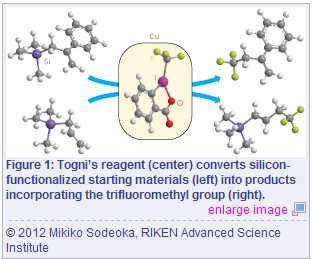기술동향
Efficient and versatile chemistry
- 등록일2012-10-10
- 조회수5631
- 분류기술동향 > 종합 > 종합
-
자료발간일
2012-10-05
-
출처
Riken Research
- 원문링크
-
키워드
#Efficient#versatile#chemistry#pharmaceutical
Efficient and versatile chemistry
More pharmaceuticals could benefit from the stabilizing influence of fluorine atoms, thanks to an innovative reaction method for attaching them

Molecules with potent bioactivity alone are not suitable for new medicines. They must behave well inside the body, being easily absorbed, yet metabolically stable, once circulating through the blood stream. Adding fluorine atoms is a proven way to improve these properties. Now, this approach is set to expand thanks to a technique developed by Mikiko Sodeoka and her colleagues at the RIKEN Advanced Science Institute in Wako1
Sodeoka and her team’s approach is to attach fluorine in the form of the trifluoromethyl group, -CF3, a small side chain that adds three fluorine atoms in a single transformation. Since trifluoromethyl groups are hydrophobic, they help the drug to infiltrate the body and reach its site of action. The carbon?fluorine bond is also very strong, improving the drug’s stability. “These factors are crucial for the development of therapeutic drugs and agrochemicals,” Sodeoka says.
Despite the advantages offered by trifluoromethyl groups, the narrow range of substrates to which they can be attached currently has limited their use. While methods for attaching the group at a carbon?carbon double bond are well established, only a few approaches exist for attaching the group at other sites on the molecule.
Sodeoka’s strategy was to first functionalize the target molecule with a silicon-based side chain to form an allylsilane, a well-understood functional group. The researchers showed that the allylsilane activates the molecule to react with a suitable trifluoromethyl source, a copper-activated form of a molecule known Togni’s reagent. This generates a product in which the trifluoromethyl group is attached at a singly bonded carbon (Fig. 1).
“To date, these trifluoromethylated compounds have been difficult to make-our reactions provide a general and efficient method for constructing these types of compounds,” Sodeoka says. “We hope that these compounds will contribute to the creation of new trifluoromethylated pharmaceutical drugs.”
The process is versatile because the silicon group can be either eliminated or retained during the reaction, depending on the structure of the ing molecule. Leaving the silicon in place offers a way to further functionalize the molecule at that position, if required.
The team is currently investigating the reaction’s exact mechanism, particularly regarding the trifluoromethyl source. Only certain copper species work, the researchers found, and the reasons why remain unclear.
Sodeoka and colleagues are also looking to push into new areas of trifluoromethylation chemistry. “We want to develop new types of trifluoromethylation reaction that could provide more complex and useful trifluoromethylated building blocks,” she says.
The corresponding author for this highlight is based at the Synthetic Organic Chemistry Laboratory, RIKEN Advanced Science Institute
- Shimizu, R., Egami, H., Hamashima, Y. & Sodeoka, M. Copper-catalyzed trifluoromethylation of allylsilanes. Angewandte Chemie International Edition 51, 4577?4580 (2012). article
-
이전글
- [우수 논문소개] Corticospinal 시스템의 발생 과 진화 조절 메카니즘 규명
-
다음글
- [신진연구자 컬럼] 핵산 나노기술(Nucleic Acid Nanotechnology)의 의학적 응용
동향
- 제도동향 [KBCH 브리핑] 미국 SECURE 규제 발표 : 생명공학규제를 현대화하기 위한 ‘Sustainable, Ecological, Consistent, Uniform, Responsible, Efficient(SECURE) Rule’ 초안 발표 2020-06-05
- 정책동향 OECD Workshop on "Building an Efficient Bio-Based Economy through Industrial Biotechnology" 2010-08-06
- 정책동향 An OECD Framework for Effective and Efficient Environmental Policies : Overview 2008-05-22
- 기술동향 Baculovirus as versatile vectors for protein expression in insect and mammalian cells 2005-05-16

